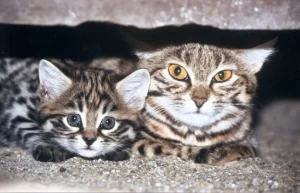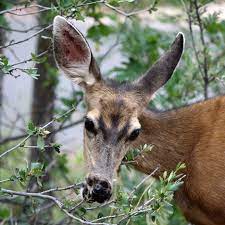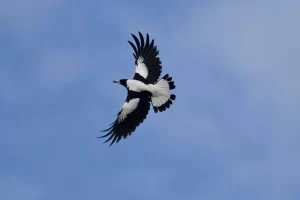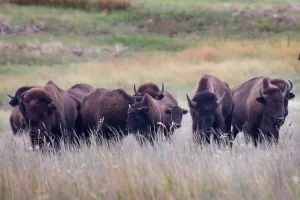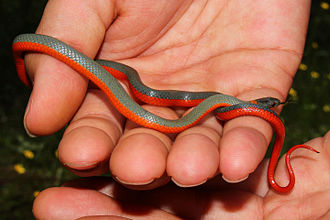This rare and secretive cat is one of the world’s smallest cats, and is Africa’s smallest wild cat. Its coat varies from tawny to cinnamon buff, and has patterns of brown or black oblong spots, which provide effective camouflage. The spots merge into bars which cover the legs, shoulders, and short tail. Feet of Black-footed cats are black on the undersides, which is where their common name comes from.

Black-footed cat
The first black-footed cat known to science was discovered in the northern Karoo of South Africa and described in 1824. It is endemic to the arid steppes and grassland savannas of Southern Africa. In the late 1960s, it was recorded in southern Botswana, but only few authentic records exist in Namibia, in southern Angola, and in southern Zimbabwe.
Due to its restricted distribution, it has been listed as a vulnerable species on the IUCN Red List since 2002. The population is suspected to be declining due to poaching of prey species for human consumption as bushmeat, persecution, traffic accidents, and predation by domestic dogs and cats. If you wanted to learn more read the full article with Pritish Kumar Halder.
Distribution
Black-footed cats live in Namibia, South Africa, marginally into Zimbabwe, and can also be found in extreme southern Angola.

Range of Black-footed cat
Steppe and savannah habitats are their preference, such as the Karoo and Kalahari Deserts. They need tree cover and sparse shrub for hunting purposes, and hollowed-out termite mounds or burrows for sleeping in during the day.
Habits and Lifestyle
Black-footed cats live solitary lives and are only found in the company of others when breeding or in the case of a mother with dependent offspring. They are strictly nocturnal, hunting only at night, sleeping during the day in abandoned termite mounds or unoccupied springhare, porcupine or aardvark burrows. Males have territories that are much larger than the females’ ones, and will overlap with as many as four females’ ranges.

Black-footed cat habits
They mark their territory with scent and the rubbing of scent. Female territories also often overlap with the areas of other females, but they always hunt on their own. In one night, they can travel as far as 16 km in their search for food. Their hunting is by a method of stalking, running and pouncing, or they wait outside rodents’ holes for their prey.
Diet and Nutrition
Black-footed cats feed mainly on mice, small lizards, insects and birds. They have adapted well to their habitat and hardly ever need to drink water.
Mating Habits
Black-footed cats are probably polygynous, because male territories overlap with those of up to five females, while the female ranges generally only overlap one male range. The mating season is from July to March. Females can have two litters per year, with often 1 to 3 kittens in each litter (though 1 to 2 is more usual). The gestation period is 59 to 68 days.

Black-footed cat
– Mating habits
The kittens start to venture outside their den when they are 3 weeks old, and at about 6 weeks old they are fully weaned, and can start to hunt their own prey. By five months old kittens are independent, but they may remain inside their mother’s range. These cats are sexually mature at 1 – 2 years old.
Population
Population threats
The most important threat comes from traps and poisons set for other animals. Farmers target the African wildcat, and so the Black-footed cat can easily become a victim of poisoned bait and steel-jaw traps, and carcasses poisoned to control locusts and jackals could kill Black-footed cats feeding on them. Furthermore, overgrazing from cattle causes habitat degradation throughout the Black-footed cat’s range, and can impact them by reducing the amount of small vertebrates which they eat.

Black-footed cat with baby
Population number
According to the IUCN Red List, the total population size of the Black-footed cat is fewer than 10,000 mature individuals. This species’ numbers are decreasing today and currently it is classified as Vulnerable (VU) on the IUCN Red List.
Ecological niche
Black-footed cats are primary predators of birds and small mammals in the areas they inhabit, controlling their populations in this way.
Fun Facts for Kids
- This species has a reputation as “vampire cats’, which is based on the ability they have to live without water. The body fluids of their prey supply all their requirements for liquid, but they will drink water if it’s available.
- Black-footed cats are not good climbers. This is because their stocky bodies with short tails make it too awkward for them to climb trees.
- Black footed cats are known for their bravery and tenacity.
- When Black-footed cats, while hunting, wait quietly with their eyes closed outside rodent burrows and dens and burrows, they are not sleeping. All their senses are alert, and they are just waiting for the slightest movement or sound of the emerging animal.
- Black footed cats occasionally will hide some of their food to eat later.
- The calls of Black-footed cats are louder than those made by other cats the same size, presumably so they can call over relatively long distances. However, when individuals are close to each other they use quieter gurgles or purrs. When feeling threatened, they may hiss and even growl.
- The kittens of Black-footed cats are born and raised in a burrow type den. The mothers will often move their offspring to a new location once they are around a week old.
Reference
https://animalia.bio/black-footed-cat?environment=331

